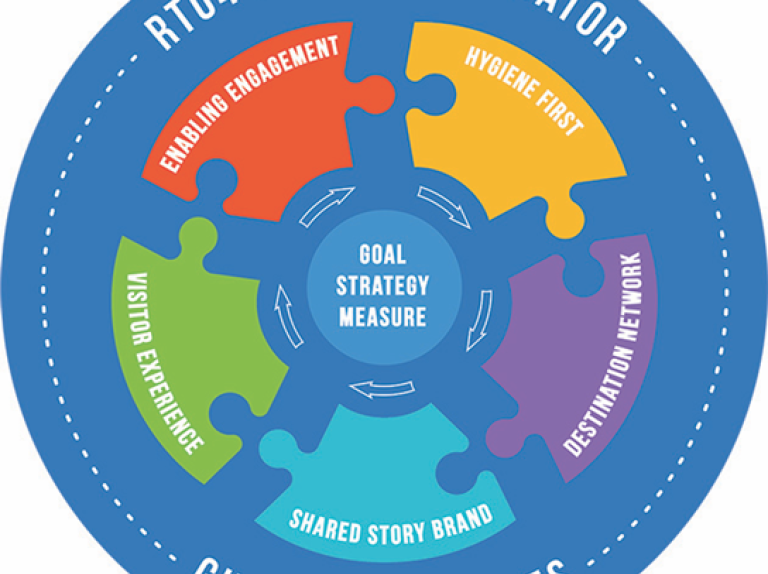
by: David Peacock, Simpleview
Ten years ago in the province of Ontario in Canada, Regional Tourism Organization Four (or RT04 Inc.) was established as a tourism development incubator to understand and address the changes taking place in tourism in the face of a rapidly globalizing world and pervasive digital disruption.
RTO4 began its work by doing A/B testing, comparing investments in traditional DMO activities such as marketing and promotion to alternative Investments such as building stakeholder and member digital competencies, fixing digital hygiene issues with key stakeholders and tourism and generators, and creating destination networks with partners who would build, guide and fund sustainable and regenerative destination development and animation.
Over that same decade, a number of key developments were happening elsewhere in the tourism industry. DestinationNEXT, commissioned by Destinations International, shone a bright spotlight on one of the most important and pressing aspects of destination management — stakeholders and how meaningful and ongoing engagement with them was essential to the future of successful destinations.
Jack Johnson and his team at Destinations International took that a step further when they created a lexicon of tourism that led us clearly to the truth that shared community values and the rapid adoption and integration of a resident- and community-based approach may well be the biggest existential challenges we face as organizations and destinations.
The COVID-19 pandemic has accelerated all of these challenges, the need for digital excellence, the pressing need to support and equip our stakeholders as partner players, and the need to build a foundation of shared community values.
“The key to successful tourism destination development is highly engaged communities that take an active role in shaping their collective future.” Andrea Gardi ED, RTO4 Inc. https://rto4.ca/
In April 2017, Multibriefs, on its tourism-industry-specific news channel, wrote an article on RTO4 entitled Canadian DMO brings Silicon Valley Approach to Tourism Marketing. The article focused on RTO4 using DMAI’s DestinationNEXT as a springboard for a proprietary destination development model that focuses on creating vibrant destinations by emphasizing capacity building, a culture of innovation, and the transfer of key skills, especially digital skills with destination network partners in order to unlock co-investment opportunities with traditional and non-traditional stakeholders. In essence, a virtuous loop of continuous destination Improvement.
RTO4: Destinatination Development Process
Over the last decade, RTO4 has partnered with domestic and international organizations around the world to develop and test innovative approaches that empower destination organizations to integrate more seamlessly with their destination partners, to elevate partner capabilities, and to work with destinations to create restorative and legacy value opportunities for both travelers and residents.
The RTO4 Destination Animation Program (RTO4 DAP) has been particularly successful in aligning local resources and initiatives to create vibrant and highly shareable destination assets. Based on some early work by Visit Dublin Ohio that focused on animating a destination’s DNA through nominal strategic co-investments, the Destination Animation Program is now a key part of all DMO work in RT04.
Similarly, the RTO4 Digital Influence Report (DIR) was built to engage and align stakeholders. The DIR assesses a destination’s overall digital footprint by measuring the individual digital fingerprint of stakeholders such as accommodations, attractions, culinary, retail stakeholders.
The DIR was initially compiled by students contracted to manually look at over 100 data points per individual operator to assess their individual digital fingerprint and provide a series of prioritized steps to optimize the visibility and shareability of that operator’s assets on the internet. In 2019, RTO4 partnered with Simpleview, the world's largest tourism content and data management company, to automate the digital influence report and create dynamic individual operator reporting. In addition to the roll-up destination report, the DIR now delivers real-time operator/member business reports with individualized actionable insights for that business or partner.
The DIR measures the cumulative digital footprint of a destination and provides the platform for stakeholder engagement on digital reputation management vis-a-vis dynamic individual operator report cards.
The DIR tool exists in a perfect trifecta for DMOs, the intersection of three pressing needs:
- It provides a structured and measurable opportunity for ongoing, meaningful, demonstrable, and productive stakeholder engagement
- It addresses the pressing need to improve the destination’s overall digital footprint to meet the consumer where and how they shop in a rapidly changing digital world
- It creates legacy value digital assets dispersed throughout the community that have enduring value and are literally “always-on” as digital channels.
RTO4, an active and engaged Destinations International member, continues to play a leading development role in Canadian tourism. Programs like the destination animation program, processes like the destination development process, and tools like the digital influence report may have been ahead of the curve before the pandemic, but in a post-pandemic world, they are exactly the kind of tools and processes that we will need as destinations to create more vibrant networks and to be more locally relevant as we craft a new model of tourism where the visitor, the resident and businesses alike are partners in regenerative travel that builds great places to live and visit.

